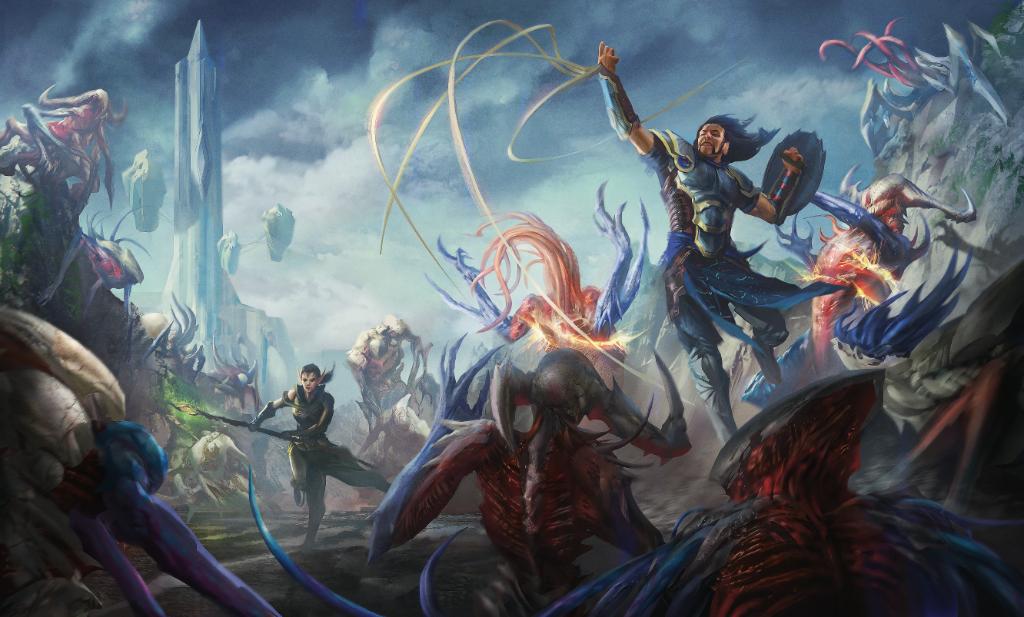It’s no secret that we like Magic: The Gathering around here. But something that has finally caught our attention and sparked our collective imagination is the format known as Modern. In short, Modern features a card pool of everything after 8th edition which is good enough to do some truly janky things without doing anything too degenerate. But there’s a lot to think about when getting into a new format, and we here at NitWitty Magazine are here to help. So we went out into the wild to explore the Magic Modern format, and now we’re here to share what we discovered, and how you can get started.
If You Build It (You Might Still Lose)
Something that I find wonderful about Modern is that for the most part it is a “solved” format. That means that there are archetypes for decks, and it is easy to figure out if a new card is going to work in an existing deck. And make no mistake – the decks in Modern are lightning quick and super polished. A low tier Modern Deck would probably wipe the floor with a Pro Tour Standard Deck faster than it takes to shuffle. For somebody that likes to build decks, it may seem like Modern is a bad format, but honestly that’s what makes it really exciting.
That’s because of how quickly it simplifies things. Your deck can win, or it can’t. It’s really that easy. Your combo is either faster than Burn, or it isn’t fast enough. Your aggro is more violent than Tron or Grixis, or you are going to get some bad beats. Your control is, well, if you brought a control deck to a modern event you’re gonna have a bad time. Or you’re playing Lantern Control, and every single person you play against is going to hate you.
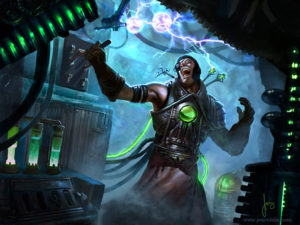 Now there is nothing wrong with going online, seeing what players at high level events are playing and just roll with that. In fact, more power to you. Feel free to focus on playing your deck as well as you can. But all of that just makes me want to brew even more since I know what the constraints are. In my cold, dark heart I am a Johnny and will always design my own decks. But with Modern anything I build I can put through its paces and know if it is going to work or not. I can have some weird idea for an infinite combo that will churn through my entire deck and deal 1000 damage, but if it takes 10 turns to set up it’s never going to be viable. Which means that I don’t need to keep trying to force it and make it happen and can move on.
Now there is nothing wrong with going online, seeing what players at high level events are playing and just roll with that. In fact, more power to you. Feel free to focus on playing your deck as well as you can. But all of that just makes me want to brew even more since I know what the constraints are. In my cold, dark heart I am a Johnny and will always design my own decks. But with Modern anything I build I can put through its paces and know if it is going to work or not. I can have some weird idea for an infinite combo that will churn through my entire deck and deal 1000 damage, but if it takes 10 turns to set up it’s never going to be viable. Which means that I don’t need to keep trying to force it and make it happen and can move on.
For my part, I’ve constructed 2 different decks that are designed for totally different things. The first was designed with the idea of being a budget deck (HA!) and since I already had the mana base from the Standard deck I built previously, it worked out. This is how I wound up constructing a Mardu Burn Deck. There’s a bit to unpack in the title. First, “Mardu” refers to the Mardu clan from Khans of Tarkir block and means the deck is red, white and black. The “Burn” part means that 90% of my deck is Lightning Bolt and Lightning Bolt shaped friends. The turn sequence is (for the most part) Draw, Attack, Play something that deals 3 damage and repeat. Burn has been called a combo deck, and the combo is to play 7 burn spells for 21 damage. Getting there without getting run over by the fastest stuff in the format is the real trick.
Most people that play Burn in Modern are either going mono-red, or Naya (red, white, green). With the mono-red version you get access to a card called Blood Moon, which makes fancy lands not work anymore and stops some decks cold. The Naya Burn deck gets to enjoy the company of Wild Nacatl which is often a 3/3 for 1 mana in that deck, which is pretty good. That style usually goes a little heavy on creatures and attacking, and is sometimes considered a blend of Burn and Aggro strategies. Personally, I like adding black since I can play Bump in the Night and Rakdos Charm which keeps me playing more spells per turn. Also, because I sometimes find cards that I feel are hidden gems, I like keeping 2 Bedlam Revelers in the deck to help close games out. In other words, even in something as “standard” as Burn there are a lot of different variants and they can play differently. So if somebody sits down on turn 1 and says, “I Lightning Bolt you,” there’s good news and bad. The bad is that you don’t know which Burn deck they’re playing, and the good news is that if they opened with that, they don’t know what they are doing.
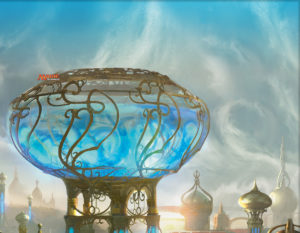 The other deck I built is called Divide by Zero. It’s rather strange and it’s built around a card called Aetherflux Reservoir and the degenerate things that it can do with Paradoxical Outcome. The play is really funny, and goes like this.
The other deck I built is called Divide by Zero. It’s rather strange and it’s built around a card called Aetherflux Reservoir and the degenerate things that it can do with Paradoxical Outcome. The play is really funny, and goes like this.
Step 1) Play Aetherflux Reservoir.
Step 2) Play a bunch of things that cost 0 mana (hence the name). Gain a bunch of life on a logarithmic progression – using equation N(N+1)/2 life where N is the total number of things played.
Step 3) Play Paradoxical Outcome, return the 0 cost things, and play them again. Gain a nasty boatload more life.
Step 4) Use Aetherflux Reservoir to deal 50 damage directly to the dome.
Unlike Burn, this is a wacky combo deck and the entire deck is built around drawing a dump truck of cards, scrying everything away I hate and gaining life for the win. In testing it seems fast enough to compete. It can beat Burn and most aggro strategies because it gains so much life and plays creatures that cost 0 so I can build a big board presence. But it’s also possible that it might not be fast enough. However, in any matchup I play I’ll know for a fact that my opponent has never seen my deck before, which is fun.
Meeting Your Match(Up)
The decks in Modern, for the most part, are a known quantity. If somebody sits down and plays a Glistener Elf, you can bet you are playing against Infect, and you know after playing how that matchup is likely to play out. I like to think of it like when you play a fighting game online. You pick up Ryu and your opponent is rolling in the deep with Zangief. You both know what the weaknesses of the other player are and how you need to play to maximize your strengths. You’re still playing as Ryu, but you will approach the game with a different strategy because of who you are playing against. Most Magic at higher levels is like this, but it’s brought to the forefront in Modern, so that even casual players are very familiar with the concept.
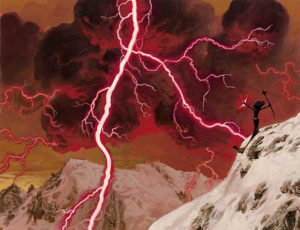 The Modern Format was introduced in 2011 and replaced the previous Extended Format. It was intended to be a “legacy” format which means that the cards don’t ever rotate out. So if you have a Modern Deck, you can play it in Modern Events for as long as you want. While at my local event I interviewed many of the players there, and one of the things that they said about Modern was that they enjoyed being able to just enjoy playing Magic. One player, a quiet soldier from our local military base said, “Yeah, I just got tired of keeping up with Standard. It just rotates out so fast now, I never get a feel for the environment or my list.” With Modern, the more you play your deck (or “list” in current Magic lingo) the better you get at playing it, until you have mastered the lines of play that deck is capable of. This was something that I discovered when my opponent played around my best threats and delivered a beatdown even as I burned them down to 6 life. Practice, it seems, makes perfect.
The Modern Format was introduced in 2011 and replaced the previous Extended Format. It was intended to be a “legacy” format which means that the cards don’t ever rotate out. So if you have a Modern Deck, you can play it in Modern Events for as long as you want. While at my local event I interviewed many of the players there, and one of the things that they said about Modern was that they enjoyed being able to just enjoy playing Magic. One player, a quiet soldier from our local military base said, “Yeah, I just got tired of keeping up with Standard. It just rotates out so fast now, I never get a feel for the environment or my list.” With Modern, the more you play your deck (or “list” in current Magic lingo) the better you get at playing it, until you have mastered the lines of play that deck is capable of. This was something that I discovered when my opponent played around my best threats and delivered a beatdown even as I burned them down to 6 life. Practice, it seems, makes perfect.
This of course creates one of the major issues with the Modern format – non-interactive games. Sometimes your deck simply will have a bad matchup against whomever you are playing. For example, one of the people that I ran into was playing Storm. That deck uses cards that quickly replace themselves, such as Goblin Electromancer and Pyromancer Ascension. To win it puts the Pyromancer Ascension into play, plays a bunch of stuff like Manamorphose, and draws cards until they can resolve a Grapeshot for lethal. It’s cool and has good matchups. But when it runs into something as fast as Burn, it just gets steamrolled. The game is basically 2 players taking turns trying to figure out who can resolve their win condition first.
You can get around this to a certain extent by making judicious use of your sideboard – 15 cards that you can swap in between games. So after game 1 if somebody runs you over with Affinity (an artifact based deck) maybe you go get those Stony Silences out of the sideboard. The thing is that there are way too many archetypes to have sideboard options for everything. So even if you built your sideboard perfectly there is still a good chance you will end up playing against a matchup where you are expected to win less than 30% of the time even if you play optimally. Coincidentally, there is a movement in Modern circles to change the sideboard to 20 cards instead of 15 to help alleviate this issue.
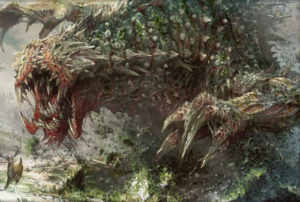 Even with that in mind seeing what your opponent played in game 1 and trying to figure out which cards from your sideboard to add or remove is a trick. For example, I was up against a green/red Ramp deck that comboed off with Madcap Experiment into Platinum Emperion, which is pretty sweet. For game 2 I figured that I should put more artifact hate into my deck, only to realize to my chagrin that the deck was actually a land destruction and big creature beatdown. Sideboarding becomes a fun meta-game in and of itself. First you try to figure out what sort of decks you may play at an event and build a sideboard to deal with it, then in individual games you’re trying to optimize your deck for the opposing deck. Unlike in Standard, the sheer number of decks makes it rewarding to find good sideboard cards since it isn’t a given.
Even with that in mind seeing what your opponent played in game 1 and trying to figure out which cards from your sideboard to add or remove is a trick. For example, I was up against a green/red Ramp deck that comboed off with Madcap Experiment into Platinum Emperion, which is pretty sweet. For game 2 I figured that I should put more artifact hate into my deck, only to realize to my chagrin that the deck was actually a land destruction and big creature beatdown. Sideboarding becomes a fun meta-game in and of itself. First you try to figure out what sort of decks you may play at an event and build a sideboard to deal with it, then in individual games you’re trying to optimize your deck for the opposing deck. Unlike in Standard, the sheer number of decks makes it rewarding to find good sideboard cards since it isn’t a given.
Watching the World (Mardu) Burn
I learned a couple of things on my way to a 2-2 finish at my Modern event. First of all, Mardu burn is legit, in spite of what the haters say. I felt that my matchups were favorable and at no point did I ever get straight blown out. Second, Divide by Zero is a little slow but shows promise and after playing something as straight ahead as burn; it’s a delightful change of pace. Which brings me to my final point. In Standard you would play decks for a few months, maybe make a few changes here and there and throw them away at rotation. In Modern the decks you own, you just own. You can play them and tailor them to your playstyle and your local metagame basically forever. This changes how you look at Magic as a whole. You can still get excited when a new set comes out, but now you look at cards and see if they could make your Modern decks better. Or if there is some janky new card that breaks the format and creates an all new archetype.
All of this means that the longer you play Modern, the better you get at playing your decks even as you improve them over time. So get out there, build yourself a deck that you’ll have fun with, and go play.






